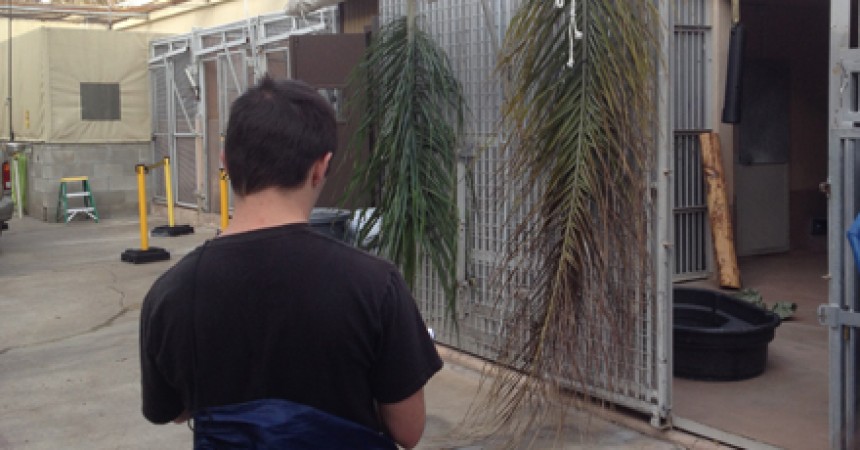Last Thursday, interns met Dr. Beth Bicknese, a Veterinarian, and Ms. Meredith Reed, a Veterinary Technician, at the San Diego Zoo. We got the opportunity to see the quarantine enclosures, pharmacy, intensive care unit, clinical pathology lab, x-ray room, and lastly, the surgery room. Dr. Bicknese and Ms. Reed are both amazing people and the veterinary department was very exciting!

My fellow intern, Mark, observes two animal quarantines at the veterinary department. When animals arrive at the Zoo, they must first be quarantined for thirty days. This is done in order to examine them for potential diseases or viruses.

Interns Ivanna, Rose, Isabella, and Belle gather around Dr. Bicknese in the keeper kitchen. This is where keepers prepare diets for all of the animals residing at the hospital at any given time. The kitchen is stocked with everything from meal-worms to copious amounts of vegetables, grains, and even dog food.

In the clinical pathology department, we were allowed to look through a microscope at a slide currently in the examination process. The picture above is of a bird’s red blood cells and white blood cells at a large magnification. A common trait amongst birds is that their red blood cells are noticeably elongated as opposed to the circular red blood cells seen in humans and other mammals.

Alon and Isabella stand near Dr. Bicknese in the intensive care unit. This room is where animals come to be closely observed and monitored. At the Safari Park a few years back, the veterinarians there had the bright idea to install a camera in their intensive care unit to observe the animals. In the wild, animals will not show that they are sick because it reveals their weakness making them susceptible to predation. Due to this instinctive behavior, animals will often not show that they are sick to veterinarians who are attempting to treat the wound or illness. However, with the cameras installed, animals do not realize that they are being monitored, which in turn allows the veterinarians to observe each animal and act accordingly.

This is the surgery room where Dr. Bicknese performs often times meticulous procedures on diseased or injured animals. The medical machines in the room look just as technical as a regular hospital. There is a small table in the center of the room and a hydraulic table out of frame in the corner for large animals.

This is the pulse oximeter which is a machine that monitors an organism’s pulse. Dr. Bicknese puts the clip on her finger and checks her own pulse to give us a demonstration. Some types of animals, like reptiles, have different types of pulse oximeter devices to adequately suit their size.

My fellow intern Alon examines the inside of a bell pepper with a scope with a small camera on the tip. This device is used for examining animals internally without having to make a large incision. It was difficult to maneuver the device through the pepper when I tried it, but once I got the hang of it, it was pretty fun!

My fellow intern Alon examines the inside of a bell pepper with a scope with a small camera on the tip. This device is used for examining animals internally without having to make a large incision. It was difficult to maneuver the device through the pepper when I tried it, but once I got the hang of it, it was pretty fun!

Meet Emilio #2, the dummy deer used for practice with the dart guns. Emilio is tattered and marked with holes from years of intense practice.

My fellow intern Isabella shoots Emilio for practice with the dart gun. Ms. Reed encouraged us to aim for the butt or leg avoiding the face and heart when shooting. If the face or heart of an actual animal were to be shot with the dart gun it could injure or maim the animal.
Wesley, Photo Team
Fall Session 2014


